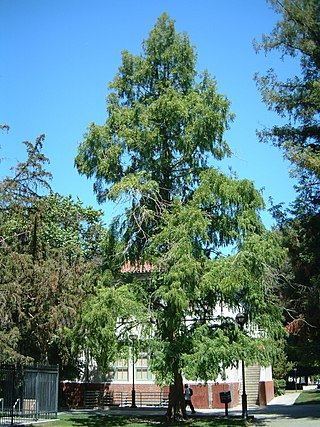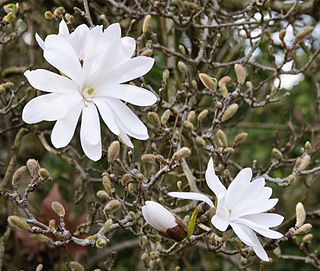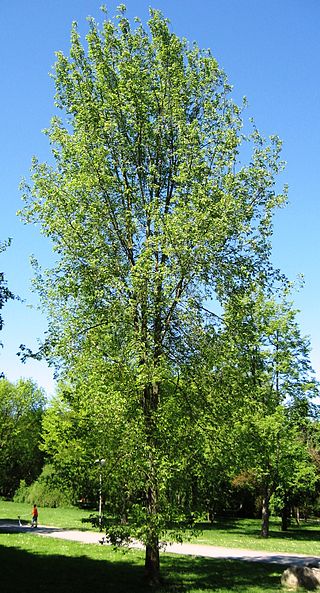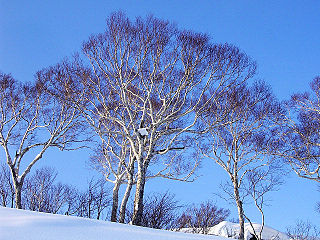
Metasequoia glyptostroboides, the dawn redwood, is a fast-growing, endangered deciduous conifer. It is the sole living species of the genus Metasequoia, one of three genera in the subfamily Sequoioideae of the family Cupressaceae. It now survives in the wild only in wet lower slopes and montane river and stream valleys in the border region of Hubei and Hunan provinces and Chongqing municipality in south-central China, notably in Lichuan county in Hubei. Although the shortest of the redwoods, it can grow to 167 ft (51 m) in height.

An arboretum is a botanical collection composed exclusively of trees and shrubs of a variety of species. Originally mostly created as a section in a larger garden or park for specimens of mostly non-local species, many modern arboreta are in botanical gardens as living collections of woody plants and are intended at least in part for scientific study.

Magnolia stellata, the star magnolia, is a slow-growing deciduous shrub or small tree native to Japan. It bears large, showy white or pink flowers in early spring, before its leaves open. This species is closely related to the Kobushi magnolia, and is treated by many botanists as a variety or even a cultivar of that. However, Magnolia stellata was accepted as a distinct species in the 1998 monograph by Hunt.

The H. H. Hunnewell estate in Wellesley, Massachusetts was the country home of H. H. Hunnewell (1810–1902), containing over 500 species of woody plants in 53 families. The estate remains in the family, and includes the first (1854) topiary garden in the United States, featuring intricate geometrically clipped native Eastern white pine and Eastern arborvitae. A collection of specialty greenhouses feature over 1,000 plant species. The estate has been cared for by six generations of the Hunnewell family.

Klehm Arboretum & Botanic Garden is a nonprofit arboretum and botanical garden located at 2715 South Main Street, Rockford, Illinois.
Michael A. Dirr is an American horticulturist and a professor of horticulture at the University of Georgia. He is an expert on woody plants.

Ulmus davidiana var. japonica, the Japanese elm, is one of the larger and more graceful Asiatic elms, endemic to much of continental northeast Asia and Japan, where it grows in swamp forest on young alluvial soils, although much of this habitat has now been lost to intensive rice cultivation.

Ulmus 'Regal' is an American hybrid elm cultivar developed by the University of Wisconsin–Madison and released in 1983. 'Regal' was derived from seeds arising from the crossing of the Dutch hybrid clones 'Commelin' and '215' sent in 1960 by Hans M. Heybroek of the Dorschkamp Research Institute for Forestry & Landscape Planning, Wageningen, Netherlands.

The hybrid elm cultivar Ulmus × hollandica 'Smithii', commonly known as the Downton Elm, was one of a number of cultivars arising from the crossing of the Wych Elm U. glabra with the Field Elm U. minor. The tree was originally planted at Downton Castle near Ludlow, as one of a batch, not all of them pendulous in habit, raised at Smith's Nursery, Worcester, England, from seeds obtained from a tree in Nottingham in 1810.

The hybrid elm cultivar Ulmus × hollandica 'Wredei', also known as Ulmus × hollandica 'Dampieri Aurea' and sometimes marketed as Golden Elm, originated as a sport of the cultivar 'Dampieri' at the Alt-Geltow Arboretum, near Potsdam, Germany, in 1875.

The Wych Elm cultivar Ulmus glabra 'Lutescens', commonly known as the Golden Wych Elm, arose as a sort of a wych found in the York area in the early 19th century by W. Pontey of Pontey's nursery, Kirkheaton, Huddersfield, who propagated and distributed it. The original tree he named the Gallows Elm for its proximity to a gallows near York. Loudon in The Gardener's Magazine (1839) identified it as a form of Ulmus montana, adding 'Lutescens' by analogy with Corstorphine sycamore, Acer pseudoplatanus 'Lutescens'.

The American Elm cultivar Ulmus americana 'Princeton' was originally selected in 1922 by New Jersey nurseryman William Flemer of Princeton Nurseries for its aesthetic merit. 'Princeton' was later found to have a moderate resistance to Dutch elm disease (DED).

The American Elm cultivar Ulmus americana 'Valley Forge' was raised by the Agricultural Research Service in Maryland. The tree was released to wholesale nurseries without patent restrictions by the U. S. National Arboretum in 1995 after proving to have a high resistance to Dutch elm disease. 'Valley Forge' proved only moderately successful in the US National Elm Trial, averaging a survival rate of 66.7% overall, owing largely to environmental factors rather than susceptibility to disease.

Ulmus 'Fiorente' is a hybrid cultivar elm derived from a crossing of the Siberian Elm Ulmus pumila clone 'S.10' from Lucca, Italy, with the Ulmus minor clone 'C.02' from Lungarno, Florence, by the Istituto per la Protezione delle Piante (IPP), part of the Italian National Research Council, in Florence. The tree is protected by Plant Breeders' Rights bestowed by the EU on 25 March 2010.

The 'dwarf' elm cultivar Ulmus 'Jacqueline Hillier' ('JH') is an elm of uncertain origin. It was cloned from a specimen found in a private garden in Selly Park, Birmingham, England, in 1966. The garden's owner told Hillier that it might have been introduced from outside the country by a relative. Hillier at first conjectured U. minor, as did Heybroek (2009). Identical-looking elm cultivars in Russia are labelled forms of Siberian Elm, Ulmus pumila, which is known to produce 'JH'-type long shoots. Melville considered 'JH' a hybrid cultivar from the 'Elegantissima' group of Ulmus × hollandica. Uncertainty about its parentage has led most nurserymen to list the tree simply as Ulmus 'Jacqueline Hillier'. 'JH' is not known to produce flowers and samarae, or root suckers.

Betula ermanii, or Erman's birch, is a species of birch tree belonging to the family Betulaceae. It is an extremely variable species and can be found in Northeast China, Korea, Japan, and Russian Far East. It can grow to 20 metres (66 ft) tall. It is noted for its peeling bark, which can sometimes be removed in sheets, but usually shreds and hangs from the trunk and under branches. Yellow-brown male catkins appear with the leaves in spring.
The Field Maple cultivar Acer campestre 'William Caldwell' was cloned from a seedling discovered at Caldwell's Ollerton Nursery near Knutsford, England, on 16 September 1976 by Donovan Caldwell Leaman, Director of the Caldwell's Nurseries that closed on 31 January 1992, after 212 years in Knutsford. The tree was released to commerce in 1986 R.H.S. Award of Garden Merit. (AGM) November 2022, forty-nine years after the seed was sown.

The Field Elm cultivar Ulmus minor 'Dicksonii', commonly known as Dickson's Golden Elm, is a yellow-leaved tree raised in Chester in 1900 by Dickson's Nursery, which distributed it from the autumn of 1907 as 'Golden Cornish Elm'. 'Cornish Elm' was the name often given in error to Guernsey or Wheatley Elm by the local authorities who planted the latter extensively, an error which may have influenced the choice of name by Dickson's nursery. 'Dicksonii' is usually listed as a variety of Guernsey Elm rather than Cornish Elm, Bean giving 'Wheatleyi Aurea' as a synonym, and Hillier 'Sarniensis Aurea' and later U. × sarniensis 'Dicksonii'. Clibrans' nursery of Altrincham, however, described it (1922) as otherwise identical "in habit and constitution" to 'type' Cornish Elm. The Späth nursery of Berlin distributed it from c.1913 as U. campestris cornubiensis Dicksonii. The nursery Messieurs Otin père et fils of Saint-Étienne sold an Ulmus Wheatleyi aurea pyramidalis, with leaves marbled yellow, in 1882, earlier than Dickson's introduction.
The field elm cultivar Ulmus minor'Viminalis Pendula', a weeping form of U. minor 'Viminalis', was first listed c.1890 as Ulmus antarctica pendulaHort., and briefly described, by the Späth nursery of Berlin, which distributed it from the late 19th century. On the continent it was also known as U. campestris antarctica pendula. Maxwell T. Masters in the Journal of the Royal Horticultural Society (1891) listed it as U. viminalis pendula.

Jelena de Belder-Kovačič was a Slovenian-Belgian botanist and horticulturist, who worked extensively on the taxonomy and preservation of plant specimens, gaining an international reputation for her development of the Kalmthout and Hemelrijk Arboreta. Several varieties of plants she cultivated were recognized with awards from the Royal Horticultural Society in London and she was elevated to Baroness by Albert II of Belgium for her contributions to dendrology.



















